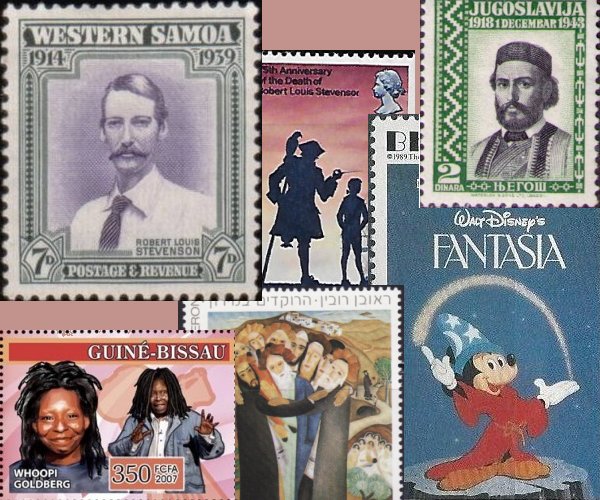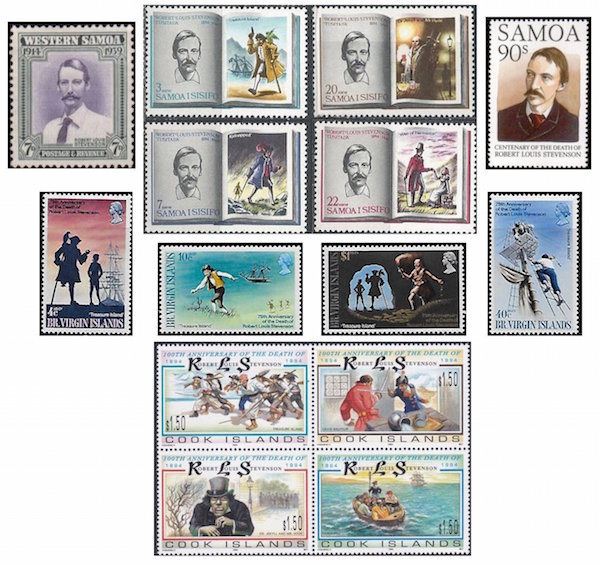The Arts on Stamps of the World — November 13
An Arts Fuse regular feature: the arts on stamps of the world.

By Doug Briscoe
For November 13th one figure stands above the rest: Robert Louis Stevenson. But we also greet French pianist Marguerite Long, Finnish composer Joonas Kokkonen, Austrian actor Oskar Werner, and EGOT winner Whoopi Goldberg today, along with a 19th-century prince-bishop of Montenegro who wrote poetry, an Israeli painter, a Hollywood art director, and a Maltese sculptor.
The poems and tales of Robert Louis Stevenson (13 November 1850 – 3 December 1894) have inspired a host of composers. But I was unaware that he himself composed over a hundred songs and short instrumental pieces! An exhaustive list has been lovingly prepared by J.F.M. Russell and can be found on his website. Stevenson loved playing the flageolet and was also an able pianist.

As for adaptations of the novels and stories, I will list just a few and refer you to Richard Dury’s excellent page for details and many more listings. Dr Jekyll and Mr Hyde has been made into operas by Wallace Earl De Pue (1974) and Barry O’Neal (1980, but not performed until 2009 in New York) and has inspired a good half dozen ballets, some using existing music. Thomas Helms and Philip Wilby composed new music for productions by the Alabama Ballet in 1999 and the Northern Ballet Theater in 2001. As for other works, Carlisle Floyd wrote a one-act opera on the short story “Markheim” in 1966; Robin Orr’s Hermiston (after the novel The Weir of Hermiston) was composed and produced (by the Scottish Opera in Edinburgh) in 1975; and just last year, in January, the Scottish Opera premièred Stuart MacRae’s full-length opera The Devil Inside, based on Stevenson’s story “The Bottle Imp”.
Even a few purely instrumental compositions can be found: Edward Burlingame Hill wrote two “Stevensonia” Suites between 1916 and 1922; Morton Gould composed an orchestral set of Jekyll and Hyde Variations in 1950; and Carl Berky’s Piano Sonatina subtitled “Weir of Hermiston” dates from 1959.
The settings of Stevenson’s poetry are legion. In addition to the beautiful Vaughan Williams cycle “Songs of Travel”, songs exist by Ernst Bacon, Seymour Barab, Granville Bantock, George Butterworth, George Whitefield Chadwick (whose birthday is also today! but no stamp), Samuel Coleridge-Taylor, Gerald Finzi, Arthur Foote, Ivor Gurney, Reynaldo Hahn (in translation), Victor Herbert, Alan Hovhaness, John Ireland, Charles Ives, Ethelbert Nevin (birthday coming up on the 25th), Hubert Parry, Roger Quilter, Vittorio Rieti, Ned Rorem, Cyril Scott, Charles Stanford, Peter Warlock, Malcolm Williamson, and many, many more.
Toward the end of his life Stevenson visited a number of the Pacific Islands. He bought land in Samoa and died there of a cerebral hemorrhage at the age of 44. He was beloved of the Samoans, who have not forgotten him in their postal issues.
Petar II Petrović-Njegoš (peh-TRO-vitch N’YEH-gosh; 13 November [O.S. 1 November] 1813 – 31 October [O.S. 19 October] 1851), Prince-Bishop (vladika) of Montenegro, did not learn to read until he was twelve, but then went on to learn Russian and French. At 14, he was tutored by the poet and playwright Sima Milutinović, who was at that time secretary of Njegoš’s uncle, the reigning vladika Petar I. This ruler, childless on account of his priesthood, considered two older nephews before turning to our poet-to-be, who succeeded his uncle at 17. I’ll leave his respectable political career for you to study on your own and deal only with his literary efforts, which are held in very high esteem not only in Montenegro but throughout the region. Proof of this, as Njegoš’s writing is held to be of greater significance than his reign of twenty years, lies in the profusion of postage stamps issued by Yugoslavia, Montenegro, Bosnia, and Serbia. Njegoš’s assumption of the mantles of authority and poetry coincided with his 18th year, though for some years he had been encouraged to write down local folk legends and tales. By the time he was twenty he had written the first of his significant epic poems. In a world of oral tradition, Njegoš stands apart as a central figure in Montenegrin and Serbian literature.

France issued a stamp for pianist Marguerite Long (13 November 1874 – 13 February 1966) just last year. She gave the first performances of Ravel’s Tombeau de Couperin (the last movement of which was dedicated to Long’s husband, who had fallen in World War I) and the Piano Concerto in G, for which Long herself received the dedication. She made the first recording of the Concerto with Ravel himself conducting shortly thereafter. With Jacques Thibaud she founded what is now called the Long-Thibaud-Crespin Competition for pianists, violinists, and—since 2011—singers.
As with Njegoš, art and statesmanship combined in the life of Romanian-born Israeli painter Reuven Rubin (November 13, 1893 – October 13, 1974), only in the sense that he also served as Israel’s first ambassador to Romania. He was born Rubin Zelicovici to a poor Hasidic family. As early as 1912 he went to Ottoman-ruled Palestine for art studies in Jerusalem, thence to Paris in the following year. He returned to Romania for the duration of World War I, then in 1921 visited New York City, where he met Alfred Stieglitz, who helped Rubin organize a show there. From Europe Rubin emigrated to Mandate Palestine in 1923 and held a solo exhibition in Jerusalem the next year. Returning from another show in New York in 1928, Rubin met his wife, a young woman from the Bronx named Esther, on board ship. Besides continuing his painting, he was involved in theater design in the 30s. It was between 1948 and 1950 that he served as Israeli diplomatic envoy to his native Romania. Rubin’s paintings deal mostly with the landscape, nature, folklore, and people of the Holy Land. He signed his first name in Hebrew and his surname in Roman letters. The stamp from 1976 shows his Dancers of Meron. The other, much older stamp of 1950 makes use of one of Rubin’s drawings of camels. Other canvases include Quartet and a striking Self-Portrait.
We have, I think, a new category for AoSotW today: art director for film. Perry Ferguson (November 13, 1901 – December 27, 1963) was born in Fort Worth and began working on Hollywood sets in 1933. Early efforts as art director were on Alice Adams (1935) and Gunga Din (1939). Over the course of his career he worked with such directors as Howard Hawks (Bringing up Baby, 1938), William Wyler, und Alfred Hitchcock and ultimately was nominated for five Academy Awards for Best Art Direction, including one for Citizen Kane (1941) and one for The Pride of the Yankees (1942). Ferguson can be seen on one of the stamps from the 2003 sheet American Filmmaking: Behind the Scenes.
Maltese sculptor Vincent Apap (13 November 1909 – 15 February 2003) is credited with the design of two stamps honoring Maltese writers, but it’s not entirely clear to me whether he also sculpted the bas-reliefs of their heads. A new School of Art had just opened in Malta when Apap enrolled in 1925. After further study in Rome he returned to the island in 1930, teaching at his alma mater from 1934 and becoming its director in 1947. One of his patrons was Louis Mountbatten.

November 13 is also the birthday of the fine Finnish composer Joonas Kokkonen (1921 – October 2, 1996). Finland has not issued a stamp for him yet, but his opera The Last Temptations (1975), held to be one of the most important Finnish operas, is included in a 2011 souvenir sheet commemorating the Finnish National Opera.
Austrian actor Oskar Werner (13 November 1922 – 23 October 1984) was born 95 years ago today. A Viennese, his birth name was Oskar Josef Bschließmayer. He was the youngest actor, at age 18, ever admitted to the Burgtheater, the Austrian state theater, where he at once used the stage name Oskar Werner. That was in October 1941. In December he was drafted into the Wehrmacht and pretended to be so hopelessly inept that he was kicked out of officer training school and put to work at menial tasks. In 1944 he secretly married the actress Elisabeth Kallina, who was half Jewish. That year they fled into the Vienna Woods and successfully evaded capture. After the war he returned to the Burgtheater and made his cinema debut in 1948. In various films over the years he played Beethoven’s nephew Karl, Mozart, and Torquato Tasso. His career was made with Truffaut’s Jules and Jim (1962). For his work in Ship of Fools (1965) he received several award nominations, including one for an Oscar, and the New York Film Critics Circle Award for Best Actor. He teamed up with Truffaut again for Fahrenheit 451 in 1966. After his appearance in The Shoes of the Fisherman his continued alcoholism ruined his career and his health. He died of a heart attack in an hotel in Marburg and was buried in his adopted country of Liechtenstein. In 1997 Austria released an Oskar Werner stamp on the occasion of the 75th anniversary of his birth.
Born Caryn Elaine Johnson in Manhattan in 1955, Whoopi Goldberg started doing standup in San Francisco. In 1983 she did a one-woman show that was seen by Mike Nichols, who brought it to Broadway. This in turn was seen by Steven Spielberg, who cast Goldberg in The Color Purple (1985). Thereafter Goldberg diversified, achieving success in standup comedy, on television, and in film. Ultimately this variety would earn her the rare distinction of EGOT, the winning of Emmy, Grammy, Oscar, and Tony awards. The Grammy came first, in 1985, for her album “Whoopi Goldberg: Direct from Broadway”. The Oscar came next in 1990 for her Supporting Actress performance in Ghost. She won a Daytime Emmy for Beyond Tara: The Extraordinary Life of Hattie McDaniel (2001). (Ironically, McDaniel had been the first black woman to win an acting Oscar, and Goldberg, half a century later, was the second.) A second Emmy would follow in 2009 for The View. Finally Goldberg won her Tony in 2002 for producing the Broadway musical Thoroughly Modern Millie. Now, about the stamps. On the left side of the 2007 minisheet from Guinea-Bissau is a stamp from the Republic of Guinea that cites her for her Golden Globe win in The Color Purple. The one from Gambia is taken from a Star Trek: Next Generation sheet; in that series and in two of the films she played the wise alien character Guinan.
Disney’s Fantasia was first released on this date in 1940. I learned from Wikipedia that, “Proceeds made on the night went to the British War Relief Society for the efforts in the Battle of Britain.” Disney cartoon stamps are enormously popular all over the world and have been issued by many countries. These of Bhutan and Grenada deal specifically with Fantasia.
A graduate of the University of Massachusetts with a B.A. in English, Doug Briscoe worked in Boston classical music radio, at WCRB, WGBH, and WBUR, for about 25 years, beginning in 1977. He has the curious distinction of having succeeded Robert J. Lurtsema twice, first as host of WGBH’s weekday morning classical music program in 1993, then as host of the weekend program when Robert J.’s health failed in 2000. Doug also wrote liner notes for several of the late Gunther Schuller’s GM Recordings releases as well as program notes for the Boston Classical Orchestra. For the past few years he’s been posting a Facebook “blog” of classical music on stamps of the world, which has now been expanded to encompass all the arts for The Arts Fuse.
